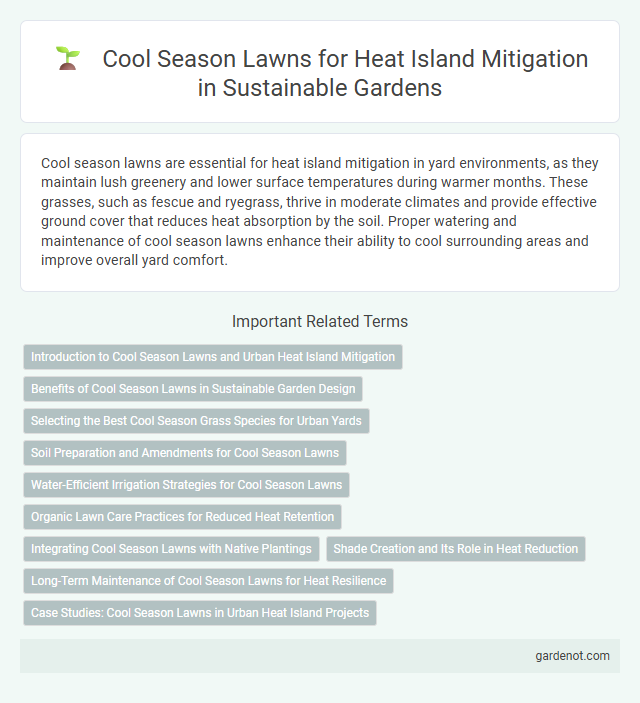Cool season lawns are essential for heat island mitigation in yard environments, as they maintain lush greenery and lower surface temperatures during warmer months. These grasses, such as fescue and ryegrass, thrive in moderate climates and provide effective ground cover that reduces heat absorption by the soil. Proper watering and maintenance of cool season lawns enhance their ability to cool surrounding areas and improve overall yard comfort.
Introduction to Cool Season Lawns and Urban Heat Island Mitigation
Cool season lawns, comprised mainly of species like Kentucky bluegrass, perennial ryegrass, and fescues, thrive in temperate climates with cooler temperatures. Their high evapotranspiration rates significantly reduce surface temperatures, making them effective in urban heat island mitigation. Incorporating cool season lawns in urban landscapes enhances cooling effects and improves thermal comfort in heat-stressed environments.
Benefits of Cool Season Lawns in Sustainable Garden Design
Cool season lawns enhance sustainable garden design by improving air quality and reducing urban heat island effects through higher evapotranspiration rates during cooler months. Their deep root systems increase soil stability and support water retention, minimizing runoff and promoting groundwater recharge. These lawns also contribute to biodiversity by providing habitat for pollinators and beneficial insects, aligning with eco-friendly landscaping goals.
Selecting the Best Cool Season Grass Species for Urban Yards
Selecting the best cool season grass species for urban yards involves prioritizing drought tolerance, shade resistance, and low maintenance requirements to effectively mitigate heat island effects. Kentucky bluegrass, fine fescues, and perennial ryegrass are among the top choices due to their adaptability to varying urban microclimates and ability to maintain cooler surface temperatures. Integrating these grasses enhances urban heat island mitigation by promoting evapotranspiration and reducing surface heat absorption.
Soil Preparation and Amendments for Cool Season Lawns
Optimal soil preparation for cool season lawns involves testing soil pH and nutrient levels to ensure a balanced growing environment. Incorporating organic amendments like compost or aged manure enhances soil structure, moisture retention, and microbial activity, promoting healthy root development. Proper aeration and adjusting soil texture with sand or peat moss improve drainage and prevent compaction, critical for sustaining cool season turfgrass during peak growth periods.
Water-Efficient Irrigation Strategies for Cool Season Lawns
Efficient water management for cool season lawns significantly reduces heat island effects by maintaining healthy turf with less water. Implementing drip irrigation, smart controllers, and soil moisture sensors optimizes water use while preventing overwatering and runoff. These strategies promote sustainable lawn care, conserve water resources, and enhance urban cooling benefits.
Organic Lawn Care Practices for Reduced Heat Retention
Cool-season lawns thrive with organic lawn care practices that enhance soil health and reduce heat retention by increasing moisture retention and promoting dense, healthy turf growth. Applying compost and mulch improves soil structure and microbial activity, which helps cool the lawn surface and decrease urban heat island effects. Regular aeration and the use of natural fertilizers contribute to deeper root systems, enabling the grass to better withstand heat stress and maintain a cooler yard environment.
Integrating Cool Season Lawns with Native Plantings
Integrating cool season lawns with native plantings enhances heat island mitigation by increasing ground cover that reflects solar radiation and reduces surface temperatures. Cool season grasses, such as Kentucky bluegrass and fescues, provide dense, green coverage during cooler months, complementing native perennials adapted to local climate and soil conditions. This combination promotes biodiversity, conserves water, and improves soil health, creating a resilient yard that helps lower urban heat effects.
Shade Creation and Its Role in Heat Reduction
Cool season lawns contribute significantly to heat island mitigation by providing dense canopy cover that creates substantial shade, reducing surface temperatures. Shade creation from grasses like Kentucky bluegrass and fine fescues lowers ambient heat by limiting solar radiation absorption on hard surfaces. This cooling effect enhances urban comfort and reduces energy consumption associated with indoor cooling.
Long-Term Maintenance of Cool Season Lawns for Heat Resilience
Long-term maintenance of cool season lawns involves regular aeration, overseeding, and appropriate fertilization to enhance heat resilience and ensure turf density. Deep, infrequent watering promotes strong root systems that withstand temperature fluctuations in urban heat island areas. Monitoring soil moisture and adjusting maintenance schedules based on climate conditions optimize lawn performance during warmer months.
Case Studies: Cool Season Lawns in Urban Heat Island Projects
Case studies of cool season lawns in urban heat island projects demonstrate significant temperature reductions of up to 5degF in surrounding areas. These lawns, primarily composed of Kentucky bluegrass, fescues, and ryegrass, enhance evapotranspiration and soil cooling, effectively mitigating heat build-up during peak summer months. Data from cities like Chicago and Minneapolis reveal improved pedestrian comfort and reduced energy consumption for nearby buildings due to strategic cool season lawn implementation.
Cool season lawn Infographic

 gardenot.com
gardenot.com